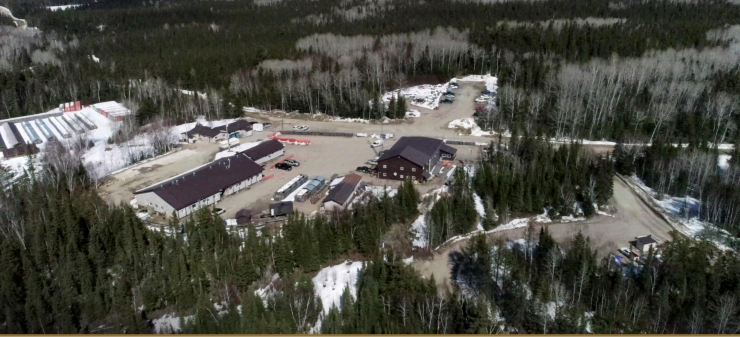IAMGOLD's Côté Gold Project will be one of a handful of mines in Canada to utilize autonomous vehicles for haulage and exploration drilling.
Company president-CEO Gordon Stothart confirmed the Toronto gold miner remains wedded to using this leading-edge technology in making an announcement of the upcoming start of construction later this year of the more than $1.3-billion, district-scale, open-pit gold mine near Gogama in northeastern Ontario.
"We won't be the first mine in Canada; we'll probably be the third mine," Stothart said in a July 21 media webcast, announcing the company's decision.
IAMGOLD and joint venture partner Sumitomo Metal Mining have given the green light to proceed with construction by the third quarter of this year of its mothballed Côté Gold Project, situated halfway between Sudbury and Timmins.
At the peak of construction during the 32-month build, the on-site workforce is expected to number 1,000 contractors by mid-2021.
When the mine enters commercial production in the second half of 2023 and full production in 2024, the operation will provide employment for 450.
Stothart mentioned there has been an autonomous fleet working in the oil sands at Suncor's Fort Hills project in northern Alberta for almost two years. Teck Resources' Highland Valley copper mine near Kamloops, B.C., started an autonomous program last year with six haul trucks, are currently up to nine, and will be expanding to 20 vehicles by year's end.
"It's been quite successful. There are significant number of autonomous sites in Western Australia, Chile and South America," he said.
"We've been keeping very close to the technology. It's looking great and really provides an opportunity for the mine of the future and will change the sweep of employment for the workforce, somewhat."
IAMGOLD and Sumitomo had put development plans at Côté on hold in January 2019, citing poor market conditions, but with current gold prices exceeding in the US$1,800 per ounce, now an economic base case can be made.
The site of the proposed Côté Project is 20 kilometres southwest of the village of Gogama, 130 kilometres southwest of Timmins and 200 kilometres north of Sudbury, the latter two being two major mine service centres.
The 500-square-kilometre property hosts a gold reserve of 7.3 million ounces, and has a current mine life pegged at 18 years, but its longevity figures to grow as IAMGOLD continues to do exploration to build reserves.
Some site prep work has already taken place this year as pre-construction activities continue throughout the summer, ramping up toward the start of mine and mill construction in the later months of this year.
According to the company's timelines, earthwork and pit development activities will begin in the second quarter of 2021. This involves preparing the tailings storage facility, the processing mill, and the mine site itself.
As mining equipment starts to carve out the pit, Stothart said early mining operations will begin at the end of 2021.
This long-awaited development figures to be a boon to neighbouring communities, particularly First Nations, which figure to strongly benefit from the mine's economic spinoffs.
Last year, IAMGOLD inked impact benefit agreements (IBA) with two area First Nation communities – Flying Post and Mattagami – on whose traditional lands the mine will be situated.
IBAs are usually confidential deals between a mining company and a First Nation community, generally involving employment, training and contracting opportunities, and sometimes even ownership through the issuance of shares.
The specific number of jobs slotted for Indigenous workers hasn't been established yet, Stothart said, but he added there's already been a strong presence on site involving First Nation-owned companies engaged in tree clearing and camp construction, "and we expect to continue that."
Moving into the mine's production phase, there will be training and development opportunities in the communities for members to take on operational roles.
Stothart noted there are skilled tradespeople available among the community membership, "and it's our expectation that Côté will be a really attractive place for many of them to be working at."
Mattagami First Nation Chief Chad Boissoneau was thrilled with what his community has negotiated with the IBA, an effort that's been worked on for a number of years. The area slated for development has been used by members of both communities for trapping, hunting and other uses.
"It wasn't hard to come to an agreement, but we had to take into consideration a lot of different effects that the mine was going to have on the water system and on the animals – everything that the First Nation people use today and in the past."
Boissoneau said the agreement helps the community financially, economically, and also for educational and health purposes.
"We'll be able to probably employ anyone and everyone that's willing and able to work through training programs, whether it's in the mill or in the pit, heavy equipment or the variety of other areas that the mine has to offer."
Regulatory approvals have been granted to IAMGOLD for the mine's environmental assessment and closure plan, as well as receiving permits related to its fish habitat and tailings management plan. Other permits are being applied for related to fish collection, access roads, dams and reconnections, industrial sewage and aggregate sourcing.




